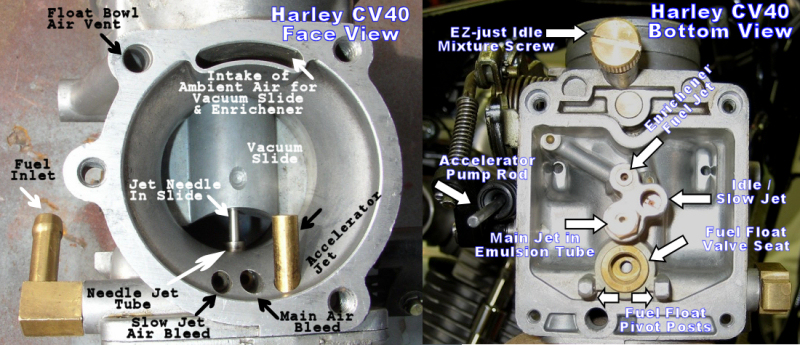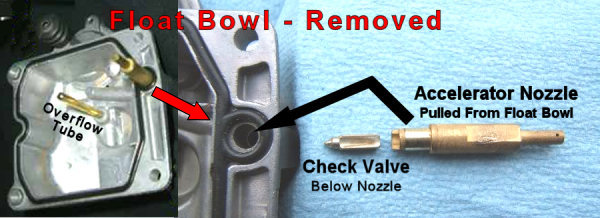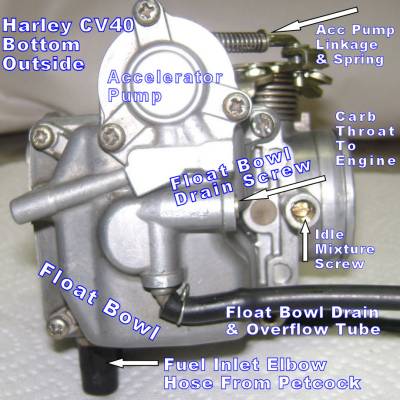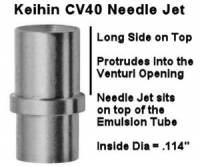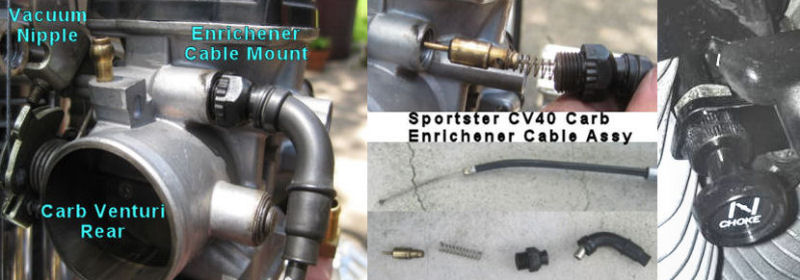Table of Contents
This is an old revision of the document!
EVO: Carburetor, Intake Manifold & Exhaust
CV CARBURETOR DESIGN
Design Info
Some Tuning Considerations
To obtain a perfect tune, for a specific bike, would require a number of dyno runs with mini-changes done to the timing & carb AFR between runs. Even then, perfection is most often fleetingly confined to a narrow portion of the throttle curve, while the remainder is 'good enough', but not perfect.
With most DIY riders, who wish to tune their own bikes, they don't have access to cheap dyno time and they don't have a collection of needles & jets to perfectly tweak the tune. Instead, they are mostly confined to having one or two needles and a few (maybe 3 or 4) jets to make AFR changes. Timing could be adjusted where there is a cam sensor plate, but after 2004, the timing was held captive inside the ignition module. This required a computer to access and change it or the rider must rely on the local dealer to 'reflash' the latest upgrade and hope the MoCo got it right.
Even so, if done methodically, with careful attention to detail, most DIY riders do get their tune 'close enough' to match the modified air cleaner & exhaust upgrade (generally known as a Stage One upgrade) with just a handful of parts.
Over the years there have been many different approaches to tuning the CV carb - some of them simply distorting the tune to skew it's operation toward some (perceived) 'enhancement' of a specific part of the throttle operation curve. Unfortunately, when most of this advice is followed, the normal street rider is left with 'problem' areas in the overall throttle curve and they then use 'trial & error' with many other changes to address those 'tune created' problems. It doesn't take long to be confused and dissatisfied.
With the collected results of many years of (reported) experimentation, some of the older suggestions have been found to be unacceptable for a good overall carb tune. Therefore, just because it was recommended in the past does not make it a good idea. This is especially true where permanent modifications (damage) are suggested for the stock carb parts. In the XLForum, there is quite a general consensus (although some still disagree) that a well tuned carb for the entire throttle curve, is one with NO permamently modified carb parts, but rather, that tune only uses a change in the needle and jets while carefully tuning the carb adjustments.
Another issue created by the factory carb settings to meet EPA regs, is that the CV carb has often had off-idle carb farts with the factory tune, which flare up with stage 1 modifications. There have been a number of proposed 'solutions' to the carb fart problem (with some of those 'solutions' creating other issues).
Below you will find many collected suggestions that should get a Stage One, 1200cc Sportster properly tuned for a balance of performance and smooth, reliable, street operation. The same principles will apply to 883 models and also to somewhat-upgraded (1250/1275) engine sizes, but with the necessary parts altered to meet the needs of the particular engine.
WORKING WITH CV40 CARBURETORS
Diagnosing CV Carb Issues
Eliminate Intake Air Leaks Mounting the CV Carb properly is critical. Check when mounting (or remounting or having issues with) the carburetor that the alignment between the carb and the manifold is correct. The reason this is so important is because misaligned mounting will cause tuning problems because any leaks will alter the Air-to-Fuel Ratio.
Before inserting the carb into the manifold rubber seal, apply a very light coating of oil around the inside of the rubber seal - This helps prevent the rubber from distorting during the insertion.
Use a bracket to actually mount the carb to the cylinder-heads - Don't just hang it on the manifold.
If you are using breather bolts (1991-2006), insert them through the banjo fittings - with sealing washers on either side of the banjo fittings - Then through the mounting bracket and into the cylinder-head mounting (breather) holes - add washers behind the bracket to take up any additional space that remains between the support bracket and the cylinder-heads…
See the section titled "Mounting the CV Carb - Preventing Air Leaks"
This process will give you a good rigid mount of the carb to the cylinder-heads while maintaining a good alignment of the carb with the manifold, all working together to eliminate those pesky intake air leaks.
1)
Check the Slide Diaphragm - Be sure the slide operates correctly & the diaphragm is not torn or punctured. To do this, remove the air cleaner and reach your finger into the carb throat to the slide - push the slide up and quickly let the slide fall down. You should hear the vacuum sound as the slide returns to the bottom position.
This is from an XLForum thread: chrishajer wrote - CBAS5 and I were talking about what it should sound like, good, and we filmed that one. Then he said “you know, we should show a bad one too” so we did that. I think the [vacuum] sound and the speed that the slide comes down are the two most important things. Those things you can't describe to someone really. I can't anyway. But it's absolutely the best way to verify that the diaphragm is seated properly.
YouTube Video of GOOD working slide ………
YouTube Video of MALFUNCTIONING slide
Mixing Parts from various carb kits (such as needles, emulsion tubes, springs, etc.) can lead to major issues when trying to get the tuning right. A mix of parts may lead to one particular operation working correctly while nearly always disturbing the proper functioning of the carb across the entire operational range, from idle to WOT. Do not mix parts. The OEM/Keihin parts allow a proper tune with only minor changes to the jetting choices.
Slow jets from fixed venturi carbs look the same as the ones used in CV carbs. However, the air bleed hole sizes are different on fixed venturi carbs and must not be used in CV carbs. 2)
Before Tuning - Collect Your Information
To prepare for tuning, start by checking what parts are in your carburetor. The factory jets and slide tube may have been altered to aftermarket parts. Some aftermarket parts are not compatible with factory parts. When buying rebuild kits, there may be extra parts not needed for your particular carb model.
When tuning, it is often less expensive to just buy the parts you actually need rather than tuning kits, which can get pricey. So planning ahead is a good idea. Know what you have before buying additional parts.
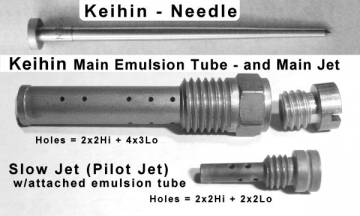 The “DynoJet” kits (and many equivalent ones) can be an issue. Typically, they replace the factory needle, emulsion tube, main jet & diaphragm/slide spring. They also recommend that you drill the slide vacuum hole out for quicker throttle response. The DynoJet emulsion tube and main jets are not compatible with the Keihin emulsion tube/jets - they use different threads. There are even FAKE Dynojet kits that have shown up on the market, presumably from China 3)
The “DynoJet” kits (and many equivalent ones) can be an issue. Typically, they replace the factory needle, emulsion tube, main jet & diaphragm/slide spring. They also recommend that you drill the slide vacuum hole out for quicker throttle response. The DynoJet emulsion tube and main jets are not compatible with the Keihin emulsion tube/jets - they use different threads. There are even FAKE Dynojet kits that have shown up on the market, presumably from China 3)
To check for DynoJet parts, look at these 4 things: 4)
- Check the Needle: Stock is Nail-shaped - DJ has grooves & a clip
- Check the Diaphragm/Slide Spring: Stock is 6.0“ - DJ is 5.75”
- Check the Slide Vacuum Port Hole (not the center hole): Stock is .097“ - DJ is .136” (Is the hole smaller or larger than 7/64“ drill bit?)
- Check the Main Emulsion Tube : Stock has 2x2Hi+4x3Lo Emulsion Holes - DJ uses only 2Lo Holes
- The stock Keihin Emulsion Tube uses 6mm Main Jets - The DJ one takes only 5mm jets, which are incompatible with the Keihin tube and only available from DJ
Here's the Dynojet Fraud Alert Press Release regarding counterfeit jet kits:
dynojet-pressrelease-knockoffjetkits.pdf
While some people have had satisfactory results with the DJ kits, if you are having trouble getting a good tune on the carb, I would remove all DJ items and restore the carb to Keihin parts including buying another slide if it's been drilled. The stock parts are good quality and will provide excellent operation if the carb is tuned properly.
From the factory, there is a cap over the Idle Mixture Screw. This needs to be removed to make IMS adjustments during tuning. It does not need to be replaced when done, but the cap is available as HD P/N 28015-01 if you would like to replace it when done making changes.5)
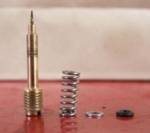 The Idle Mixture Screw “packing” (spring, washer, o-ring) and the screw itself was never meant to be removed or tampered with, according to the MoCo, due to EPA regulations. This was adjusted and the screw covered with a soft aluminum cap at the factory before initial installation on your bike. None of these packing items are offered as replacement parts from your HD dealer, so you will need to look to the aftermarket suppliers for parts.
The Idle Mixture Screw “packing” (spring, washer, o-ring) and the screw itself was never meant to be removed or tampered with, according to the MoCo, due to EPA regulations. This was adjusted and the screw covered with a soft aluminum cap at the factory before initial installation on your bike. None of these packing items are offered as replacement parts from your HD dealer, so you will need to look to the aftermarket suppliers for parts.
To remove the IMS cap, carefully drill a small hole in the center of the cap (barely enough to make a hole). Be extremely careful not to overdrill into the cap because you will damage the screw that is behind the cap. Now, carefully twist in a sheetmetal screw about one thread, then pull on the screw to remove the cap.
An aftermarket kit (like E-Z-just) can be purchased with an extended screw head for hand tuning. It comes with the “packing” in case yours has been damaged or is not functioning properly. But, check your local regulations before changing this out to an aftermarket part. You can also find, buy or barter for used parts. (“Please note: it is a violation of federal law to tamper with or disable any emission or noise control device. That is your PSA for the day”6)).
Checklist Of What You Have - In order for others to provide quality advice, it is important that you know and can provide quality information about the build of your bike. Here's a list of important information for you to know and provide for TUNING of the CV carburetored EVOs (1986-2006):
| Engine Size | (Stk883, Stk1200, Stk1100, Stk900, Stk1000, Conv883-1200, Conv883-1250, etc.) |
| Heads Installed | (Stock 883, Stock 1200, Specify Brand/Model) |
| Cam Installed | (Stock D, Stock W, Specify Brand/Model) |
| Compression Test | ( Min120PSI for 883 - Min150PSI for 1200 ) |
| Ignition Module | (Stock 883, Stock 1200, Specify Brand/Model#) |
| VOES being used | (Y/N) |
| VOES Vacuum Mod'd | (Checked/Changed the Switch Point?) |
| Air Cleaner | (Stock, Specify Brand/Model) |
| Breather Venting | (Head Into Carb, Head Out to Air, Crankcase) |
| Exhaust | (Stock, Specify Brand/Model/Baffles/TqCones) |
| Spark Plugs Used | (Stock, Specify Brand/Model#) |
| What Model Carb | (Stock CV, Specify Brand/Model) |
| Check for Intake Leak | (Y/N) (Use UNLIT propane torch near manifold ports) |
| Petcock | (Stock Vac, Modified, Specify Brand/Model#) |
| Vacuum Line Checked | (Y/N) |
| Enrichener Cable Seated | (Y/N) |
Inside of CV Carburetor:
| Slow Jet | (Stock, Specify Known Size) |
| Idle Mixture Screw | (Set at xxx turns from lite seat) |
| IMS set by Idle Drop | (Y/N - Did you change it?) |
| Drilled Slide? | (Y/N - Based on who's recommendation?) |
| Altered Slide Spring? | (Y/N - Based on who's recommendation?) |
| Jet Needle | (Stock, DJ, Other Keihin, Specify Brand/#) |
| Emulsion Tube | (Stock, DJ, Specify Known Brand/#) |
| Main Jet | (Stock, DJ, Specify Known Brand/Size#) |
| Fuel Float Level Set | (Y/N - Stock, Other) |
| Fuel Float Valve | (Y/N - Cleaned & Checked, Replaced) |
TIPS
If you don't know your engine size, check it with a straw - Like this: * Put in 5th gear * Lift rear wheel * Remove spark plugs * Place a long plastic straw in the spark plug hole * Rotate tire to move cylinder to bottom dead center - lowest straw position * Check cylinder diagonal dimension from far bottom of cylinder to lip of spark plug hole * 883 bore = 5.5" Diagonally ---- (Actual Bore Dia. is 3.000) * 1200 bore = 5.875" Diagonally - (Actual Bore Dia. is 3.498) The plastic straw is unable to damage the cylinder and unlikely to fall into the cavity...
Before Tuning - Setup Everything Else
Following an organized and thorough PreOp and Parked checklist will help you understand what you observe when you actually begin the operational testing of the carb during rides…
Here's my suggested list (for 1200 models, although 883s should be mostly the same except maybe the initial jetting) - Even if you've done some of these, being orderly and thorough, doing everything on the checklist will have benefits, especially if you've made changes since your last efforts at tuning…
Check Items Ahead of the Carb
- Check your vacuum lines for good connection & no cracks
- Check your VOES - that it switches with vacuum - later check switching point
- Check your gas tank for debris - remove & clean if needed
- Check your petcock for leaks (bad diaphragm) - Make sure vacuum petcocks open on vacuum
- Check gas line & connectors for wear/breaks/pinches
- Check your petcock for flow rate - Pull the hose from the carb, open petcock (draw vacuum if needed)
- How long does it take to flow one quart (32oz) of fuel?
Internal Carb Checks
- Carefully disassemble carb and all parts - Clean the carb body & each part
- Spray *ALL* ports, passages & jets - Get everything clean to start
- Check your float bowl - clean passages - remove any debris - set/check float level (see below)
- Use only the 4-sided type Float Bowl Valve (not the 3-sided type)
- I prefer eliminating any non-Keihin parts (ie., dynojet kits, etc.)
- (DynoJet Kits may have changed jets, needle, spring, drilled diaphragm, etc.)
- Check/Clean Emulsion Tube (which holds Needle Jet in place and mounts Main Jet)
- Pull Needle Jet - Make sure it's clean & properly installed (Long Side Up)
- Start with 175 or 180 Main Jet in Emulsion Tube (not critical until WOT settings)
- Start with 42 or 45 Idle Jet - Do not start with 46 or more - change later if needed
- Use a standard Keihin needle in slide (no washers to start) (1200 likes N65C Needle)
- Use stock spring & needle cage (spider)
- Check Diaphragm condition - no tears - seat it carefully (properly) on install
- Check Slide moves smoothly up & down with no burrs or catches
- Check Accelerator pump - Point spray hole directly at main needle
- Be sure to reinstall pump rod correctly
- Be sure you have removed each part, cleaned the ports & reinstalled correctly
- Set the Idle Set Screw (located on the right side of the carb, near the throttle cables)
so that the Throttle Plate is between the Idle Port (one hole in the carb throat) and the
Transfer Ports (which consists of 5 holes nearby)
Click on the small image below for the detailed instructions regarding setting the float level:

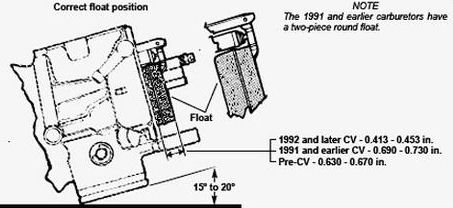
External Carb Checks & Adjustments
- Check intake seals on manifold (at heads) - replace now while it's apart
- Check intake seal between manifold & carb - replace now
- Minimize Throttle Plate opening at idle - Set it between Idle Port & Transfer Ports (See this XLForum thread)
- Check Idle Mixture Screw (IMS) screw/spring/washer/o-ring condition - clean port
- Check IMS seat (Has the screw needle tip deformed the hole?)
- Set initial IMS to 2-1/2 turns out from lite seat
Change the Screws
Replace the mounting screws used for the float bowl and for the diaphragm cover. They come with standard metal Phillips head screws. Replace these with Stainless Hex Socket Head (Allen Head) Screws. Using lock washers & flat washers in stainless is also a good idea.
Both sets of screws are 4mm Dia X .70 Thread Spacing. The socket head screws take a 3mm hex wrench.
You'll need (4) screws that are 16mm in length for the float bowl. Then you'll need (3) screws that are 16mm in length and (1) screw that is 20mm in length for the Diaphragm Cover. If you choose to use Button Head Socket Screws for the top cover, they use a 2.5mm hex wrench.
You can also replace the (3) Accelerator Pump screws with 4mm x 10mm long. 7)
Reinstall Carb & Air Cleaner
- Be sure to use light oil coating on intake manifold seal to help slide carb into place
- You MUST use (some type of) a bracket to actually mount the carb to the cylinder-heads
- Check that mounting the carb does not disturb its position in the manifold
- Reference the section titled ”Mounting the CV Carb - Preventing Air Leaks“
- BE SURE to check that your throttle cables fully open & close the Throttle Plate!
- If your heads use breather bolts - Use external head breather system to eliminate oil in air cleaner & cylinders
- Do not lubricate the enrichment cable (misnamed Choke) on CV Carburetors - tension is needed. 8)
DETAILED TUNING ADVICE
Adjust Carb Idle Circuit
- ALL TUNING should be done after the engine has warmed up thoroughly - Try a 10-20 minute ride…
- Be sure the Throttle Plate is set (at idle) between the Idle Port and the Transfer Ports
- See the “idle drop method” mentioned in the “Detailed Tuning Advice” section below
- Engine Idle Adjustment Speed: 900-1050 RPMs
- Check carburetor-to-manifold-to-heads for air intake leaks - Unlit propane torch will alter idle
- Adjust Idle Screw and Idle Mixture Screw so bike idles well
Check Transfer Circuit
- Check Accelerator pump - Twist throttle, see that it squirts directly at main needle
- Check Response to Blipping the Throttle (while parked) - should be clean & responsive
- Discussion thread regarding the relationship between the transfer ports and the pilot jet: http://xlforum.net/forums/showthread.php?t=1635658 9)
Other Engine Checks
- Check engine compression - Keep record for later comparison - Preferred Minimum 883=120psi - 1200=150psi
- Warm up engine - Try a 10-15 minute ride - let engine cool just enough to touch
- Remove Spark Plugs & Air Cleaner - Connect gauge to Front Cylinder
- CRITICAL - Manually Hold Carb Slide Open & Fully Twist Open Throttle
- Crank Engine about 5-7 cycles - Repeat procedure on Rear Cylinder
- Cold & Warm Readings can be helpful - Let engine completely cool - Take Reading on Each Cylinder
- Check engine timing - Record for future
Links About Tuning
- Cantolina's Index List of Carb-related Threads: http://xlforum.net/forums/showthread.php?t=642408 10)
- The idle drop method of adjusting the CV carb idle mixture: http://xlforum.net/forums/showthread.php?t=31262 11)
- Post a thread of your own on XLForum.net with your information from above and ask for help in tuning your particular engine/carb combination
Sub-Documents
Mounting the CV Carb - Preventing Air Leaks
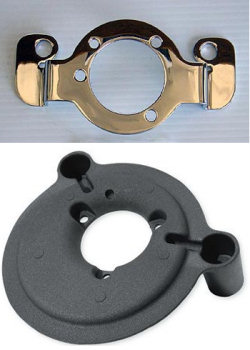 Air leaks are a common problem on carburetored bikes. Most often because not enough attention is paid to the alignment of the carb, bracket, manifold & heads when installing them. You MUST use a bracket of some sort, whether alone or part of the air cleaner backing plate, to mount the carb to the cylinder heads - the carb CAN NOT be supported by simply placing it on the manifold.
Air leaks are a common problem on carburetored bikes. Most often because not enough attention is paid to the alignment of the carb, bracket, manifold & heads when installing them. You MUST use a bracket of some sort, whether alone or part of the air cleaner backing plate, to mount the carb to the cylinder heads - the carb CAN NOT be supported by simply placing it on the manifold.
Install new manifold seals in the head intakes, especially if you have more than 5000 miles on the existing ones - they do wear out and leak. Loosely mount the manifold. Without installing the carb-to-manifold seal, carefully place the carb in the throat of the manifold. Now, put the carb mounting bracket in place - held there by the bolts into the heads (or the breather bolts).
The idea now is to temporarily mount the carb to the bracket to check the alignment with the manifold. While the manifold mounting bolts are still loose, you can move it slightly to get it into the right position. You can also slightly move the carb bracket to get the carb in the right position. You should see an even spacing around the carb where it sits in the manifold, thereby not stressing the seal when it is later put in place.
You also need to make sure the carb mounting bracket is properly mounted to the heads. Use sufficient washers behind the mounting plate (at the heads) to position the carb in the right location in the manifold. Now is the time to get all the spacing set correctly to reduce distortion on the seals and prevent air leaks.
Now, remove the carb & bracket - Tighten the manifold-to-heads bolts to keep the manifold in the position you selected - test fit the carb & bracket again - By test fitting the carb to the manifold before installing the seal for that junction, you can see exactly how it will fit in the mouth of the manifold and make a determination whether excessive stress will be placed on the seal.
The Carb-to-Manifold seal is THE MOST OFTEN ENCOUNTERED SOURCE OF INTAKE LEAKS - Due diligence now will pay off big in minimizing the chance for a seal leak later.
Once you have confidence in the alignment of the carb & manifold, put that seal in place on the manifold - LIGHTLY OIL THE INSIDE OF THAT SEAL - this will help the carb slip into place without binding or distorting the seal.
Insert the carb, attach the carb mounting bracket (which you are now confident will not distort the carb-to-manifold positioning), and bolt it all in place.
Simply Rebuilding / Refreshing The CV Carb
Disassembly
Cleaning & Inspecting
- Make sure to take everything apart, jets, needle, accel pump, all rubber components especially.
- Examine all parts for excessive wear, damage, distortion, etc.
- Cleaning solutions/sprays vary based upon your location, needs, budget, preferences and quality. Here are some ideas:
- An overnight soak in a solution of Pinesol and water followed up with a good brush down with a toothbrush then rinse and air dry. 13)
- A 20 minute soak in a gallon of Gunk (or other) Carburetor Cleaner that has a basket inside for small parts and lowers in the can with a handle, rinse, air dry, use.
- An aerosol spray carb cleaner will also work but may not loosen all of the build up in the jets or orifices in the carb body if they're not directly sprayed through.
- Blow out all holes, jets and orifices thoroughly with forced air after cleaning.
Replacement Parts
You can purchase individual parts or a rebuild kit. The kits will not have needles, jets or the spring, washer & o-ring for the Idle Mixture Screw.
The rebuild kits are usually less than $20 and include:
- Carb-to-Manifold Seal
- Carb-to-Air Cleaner Gasket
- Float Bowl Gasket/O-ring
- New Float Needle
- New Accelerator Pump Diaphragm & Spring
- Some Misc Parts/Seals
Assembly
- Do not lubricate the enrichment cable (misnamed Choke) on CV Carburetors - tension is needed. 14)
Add'l Info & Pics -
Accelerator Nozzle, Check Valve, Float Seat - http://xlforum.net/forums/showthread.php?t=1624208
Accelerator Nozzle & Check Valve - http://xlforum.net/forums/showthread.php?t=1775068
Enrichener Function (Choke)
The CV40 has an Enrichener Circuit - It is labeled Choke on the knob, but that is a misnomer, because a choke refers to a plate that restricts the incoming air supply. The enrichener circuit actually provides a path for additional fuel to bypass the carb controls and be injected directly into the air flow at the rear of the carb venturi.
Typically, the enrichener should only be utilized when starting the engine when it is completely cold. Put the enrichener on, let the bike idle for 1-3 minutes, then ride off. Turn the enrichener off as soon as the engine warms up (perhaps within 3-5 miles of riding)…
The Enrichener Knob is a friction function device. When mounting the knob, do not overtighten the mounting nut. The resistance/friction on the enrichener cable can be adjusted with the knurled nut.
- Loosen the hex nut & remove the cable from its mount.
- Put an adj wrench on the flat part of the cable mounting sleeve.
- Carefully turn the knurled nut to loosen or tighten the tension until the knob stays pulled out on its own yet freely can be pushed back in with reasonable pressure.
- Remount the cable & tighten the hex nut.
Check that the knob moves freely in and out after mounting. Do not overtighten the hex mounting nut.
The fuel for the enrichener circuit is drawn thru a fixed jet in the float bowl. The air for the enrichener circuit is taken in thru the banana shaped inlet at the top of the carb face (see the face pic above). Sometimes when the enrichener cable is moved, or the carb has been taken off the manifold, the valve piston does not properly seat into its cavity on the carb. If that happens, additional attention must be given to properly reseating the enrichener valve piston.
An XLForum Thread showing the replacement of the cable is here: http://xlforum.net/forums/showthread.php?t=848307
& gm1ll t=1553245

